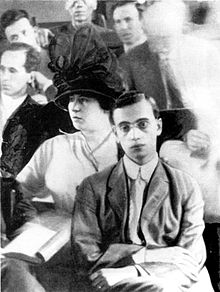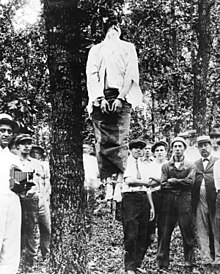Leo Frank (factory director)
Leo Max Frank (born April 17, 1884 in Cuero , Texas , † August 17, 1915 in Marietta , Georgia ) was an American factory manager of Jewish descent who was tried and convicted in 1913 for the murder of 13-year-old Mary Phagan. As early as 1913 the case led to the establishment of the Anti-Defamation League . Frank's kidnapping from prison and murder by a lynch mob at Marietta in 1915 brought the emerging anti-Semitism in the United States into the media and public focus.
Background and process
Leo Frank was the director of an Atlanta pencil factory and the murder victim, 13-year-old Mary Phagan, was his employee. The proceedings were accompanied by reports that, through their sensationalist portrayal that the factory had also had orgies and rape , contributed to a heated mood among the population and was supported by Thomas E. Watson , an influential populist politician and publicist, used to promote the establishment of the Ku Klux Klan , which had been banned by federal authorities in the early 1870s.
Condemnation
Frank was sentenced to death by the court on circumstantial evidence and, above all, the incriminating testimony of James Conley, who was convicted of aiding and abetting, for the murder of Mary Phagan , a verdict that has been viewed by several authors as a blatant miscarriage of justice .
However, the historian Albert S. Lindemann denies that anti-Semitism played a role in the indictment. There were five Jewish jurors in the grand jury who were convinced of the facts presented. The prosecutor Hugh M. Dorsey was not an anti-Semite, had expressed himself in part philosemitic and pointed out that Jews (and colored people like James Conley) had the same rights as the jury and himself Established perpetrators and built up Conley as a witness, although he changed his statements many times and interspersed clear lies. According to the prejudices of the time, he portrayed Conley as a notorious black liar, who was finally brought to the truth at the end of the questioning (as the prejudice intended). The presiding judge Roan was also very respected and free of anti-Semitic ideas.
Change of sentence and lynching
A short time after the conviction, clues emerged that exonerated Frank. John Slaton , the governor of Georgia , then commuted the death penalty to life imprisonment. However, Frank was supported by a group called "The Knights of Mary Phagan" itself ( The Knights of Mary Phagan called), abducted and at Marietta by hanging lynched . The group involved in Frank's murder included former Marietta Mayor Eugene Herbert Clay , Senator Alexander S. Clay's son , former Governor Joseph Mackey Brown , several lawyers, and a prosecutor.
Posthumous pardon
In 1982, a motion for Frank's posthumous pardon was filed with the Georgia State Board of Pardons and Paroles after a witness partially revised his testimony at the trial nearly 69 years earlier. The board objected to the pardon in 1983 because files had been lost and Frank's unequivocal innocence could no longer be established, but this was the basis for a pardon. After another motion in 1986, Frank was finally pardoned without assessing the question of actual guilt. The board instead relied on the then-inability of the state of Georgia to secure Frank's persona and right to appeal, and the state's failure to prosecute its killers.
The TV miniseries The Mary Phagan Case is based on all of these events.
literature
- Kristoff Guy: Masculinity and Modern Anti-Semitism. A genealogy of Leo Frank-Case, 1860s – 1920s (= Cologne historical treatises. Volume 54). Böhlau Verlag, Cologne 2016, ISBN 978-3-412-50545-5 ( review by Hsozkult , review by Belltower.News ).
- Steve Oney: And the Dead Shall Rise: The Murder of Mary Phagan and the Lynching of Leo Frank. Pantheon Books, New York 2003, ISBN 978-0-679-76423-6 ( digitized version ).
Web links
- Profile on jewishshirtsandgifts virtualiter library (English)
- Report at cbsnews (English)
- Leo Frank in the Internet Movie Database (English)
Individual evidence
- ↑ Elaine Marie Alphin: An Unspeakable Crime: The Prosecution and Persecution of Leo Frank . Carolrhoda Books, 2010, pp. 124, 139. For the founding of the ADL, see Blakeslee, Spencer. The Death of American Antisemitism . Greenwood Publishing Group, 2000, p. 81.
- ↑ Hang the Jew, Hang the Jew. Anti-Defamation League, accessed January 7, 2018.
- ^ Sally Steinberg-Brent: The Leo Frank Murder Case . In: Bruce Afran, Robert A. Garber: Jews on trial . KTAV Publishing House Inc, 2005, pp. 95-100, 106.
- ^ Wyn Craig Wade: The Fiery Cross: The Ku Klux Klan in America . Simon and Schuster, 1987, p. 143.
- ^ Albert S. Lindemann , The Jew Accused. Three Anti-Semitic Affairs (Dreyfus, Beilis, Frank) 1894–1915 . Cambridge University Press, Cambridge / New York 1991, ISBN 978-0-521-40302-3 , p. 239.
- ^ Leonard Dinnerstein : The Leo Frank Case. University of Georgia Press, 1987, pp. Xiii.
- ↑ Jessica Ravitz: Murder case, Leo Frank lynching live on. CNN, November 2, 2009.
- ^ Albert S. Lindemann , The Jew Accused. Three Anti-Semitic Affairs (Dreyfus, Beilis, Frank) 1894–1915 . Cambridge University Press, Cambridge / New York 1991, ISBN 978-0-521-40302-3 , pp. 251-252.
- ^ Albert S. Lindemann , The Jew Accused. Three Anti-Semitic Affairs (Dreyfus, Beilis, Frank) 1894–1915 . Cambridge University Press, Cambridge / New York 1991, ISBN 978-0-521-40302-3 , p. 253.
- ^ Albert S. Lindemann , The Jew Accused. Three Anti-Semitic Affairs (Dreyfus, Beilis, Frank) 1894–1915 . Cambridge University Press, Cambridge / New York 1991, ISBN 978-0-521-40302-3 , p. 257.
- ↑ Steve Oney: And the Dead Shall Rise: The Murder of Mary Phagan and the Lynching of Leo Frank. Pantheon Books, New York 2003, ISBN 978-0-679-76423-6 , p. 502 ( digitized version ).
- ↑ John Slaton's order, including detailed reasons for converting the death penalty to life imprisonment, is printed in: Harry Golden: A Little Girl is Dead. World Publishing Company, New York 1965 S, 320-353, here: p. 352 ( digitized version ).
- ↑ Kenneth Coleman: A History of Georgia . University of Georgia Press, 1991, p. 292.
- ^ Body of Frank is found dangling from a tree near the Phagan home. Associated Press, August 17, 1915.
- ↑ Kathy Sawyer: A Lynching, a List and Reopened Wounds. Jewish Businessman's Murder Still Haunts Georgia Town. The Washington Post , June 20, 2000.
- ↑ For the list of lynchers involved, see Stephen Goldfarb: Leo Frank Lynchers ( August 15, 2000 memento in the Internet Archive ), leofranklynchers.com, January 1, 2000, accessed August 22, 2010.
- ↑ Steve Oney: And the Dead Shall Rise: The Murder of Mary Phagan and the Lynching of Leo Frank . Pantheon Books, 2003, pp. 647-648.
- ^ Leonard Dinnerstein: Leo Frank Case . New Georgia Encyclopedia, accessed August 15, 2015.
| personal data | |
|---|---|
| SURNAME | Frank, Leo |
| ALTERNATIVE NAMES | Frank, Leo Max |
| BRIEF DESCRIPTION | American entrepreneur and murder victim |
| DATE OF BIRTH | April 17, 1884 |
| PLACE OF BIRTH | Cuero , Texas |
| DATE OF DEATH | 17th August 1915 |
| Place of death | near Marietta , Georgia |

